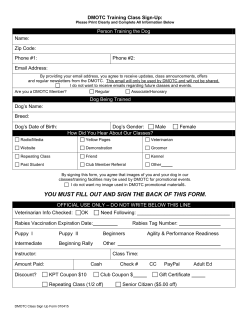
8.F.4 Construct a function to m odel a linear relationship betw een
8.F.4 Construct a function to model a linear relationship between two quantities. Determine the rate of change and initial value of each function from a description of a relationship or from two (x,y) values. Interpret the rate of change and initial value of a linear function in terms of the situation it models, and in terms of its graph or table. Jerald created the following chart to track the amount of dog food his dog ate. Day (x) Amount of Dog Food (y) 0 20 3 18 The percentage of wheat grain eaten by mice in a farmer's field is shown below. 6 16 If Jerald starts out with 20 pounds of dog food, which equation represents how much dog food (y) will be left after any day (x)? A) Which of the following is the MOST LIKELY percentage in 2005? A) 0 B) 14 C) 25 D) 45 B) In the table below f(x) is a linear function. When x= 8, what is the value of f(x)? A) 19 B) 20 C) 22 D) 26 Roberto has a certain number of songs on his IPod. Each week, he plans to add 4 more songs. After 5 weeks, he had 40 songs on his IPod. Which statement is true? A) Roberto adds 10 songs on his IPod per week. B) Roberto adds 40 songs on his IPod per week. C) The initial number of songs on Roberto’s IPod is 10. D) The initial number of songs on Roberto’s IPod is 20. A biology teacher gave three students in his class a different plant. He asked the students to record the heights of their plants, in centimeters (cm), everyday for one week. The students reported their results in different displays. Their results are shown in a graph, an equation, and a table. Part A: List the plants in order from the slowest rate of growth per day to the greatest rate of growth per day. Explain how you got your answer. Part B: If the growth rate for Plant 1 remains the same, on what day number will it be 24 cm tall? Explain how you got your answer.
© Copyright 2025














